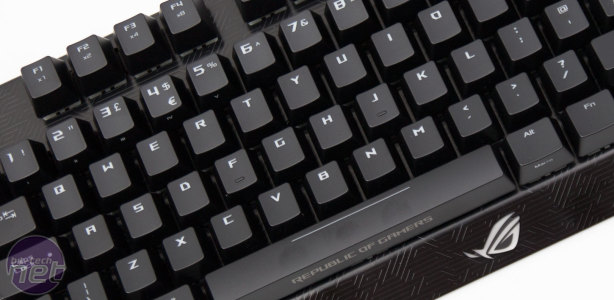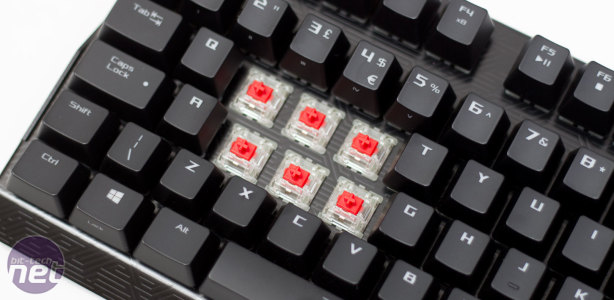
Asus ROG Claymore Review
Manufacturer: AsusUK price (as reviewed): £199.99 (inc VAT)
US price (as reviewed): $249.96 (ex tax)
Asus is a household name for most of us. With a huge market share when it comes to motherboards, GPUs, and even routers, it is going from strength to strength. One area where Asus hasn't always excelled is peripherals, but the release of products like the feature-packed Spatha mouse has started to change this. The next step is keyboards, and that is exactly what it has released now. The Claymore and the Claymore Core are Asus's answer to the gaming keyboard. These are again aimed at the enthusiast gamer, and the only difference between the Claymore Core and the Claymore is that the Core version doesn't come bundled with the removable numpad.
Inside the Claymore packaging we have the keyboard and removable numpad tucked safely inside soft velvet-like pouches. Although this is a pretty simple idea, it does add to the premium feel of the overall product. Also included in the box is a detachable, braided, 1.8m cable and a couple of ROG logo badges as well as some leaflets and warranty guides.
The keyboard itself is rather nice; there is an aluminium top plate decorated with the Asus Mayan detailing that seems to be increasing in popularity, and the metal top plate does give the board a really sturdy feel - it doesn't bend or flex at all. Without the numpad, the Claymore is very compact and has a very small footprint, yet it still has many features. A lot of the keys have secondary functions which can be activated by using the FN key, and some examples of this include media keys, lighting options, and repeating rates. Something that is a little bit different, though, is that if your motherboard supports Asus Fan Xpert, you can actually use the Claymore to increase and decrease the fan speeds, and there are also options to overclock and access BIOS. This does require you to have an Asus motherboard, which I do not have, but I did research the idea and it does look very interesting indeed. On both sides of the keyboard, there are little rubber tabs, and if you remove these, you can see some electrical contacts which coincide with similar contacts on the numpad. This allows a seamless connection without having to worry about physically looking for the connectors.
This is the numpad that is included with the Asus Claymore. There is a large wheel at the top, and this controls media volume; you can mute the audio by pressing the wheel. Again, the numpad has an aluminium top plate with the same Mayan detailing ensuring everything is aesthetically pleasing and ties together.
This is where the Claymore really gets interesting. The numpad can be attached to either side and is fully mechanical as well as being fully programmable. This means you can have your standard numpad whilst working, then once you finish, switch the numpad over to the left for gaming fun. You can reprogram the keys to be a whole set of macros, or you could even use it as your movement keys in games. We were far more impressed with the numpad than we were expecting; we have seen similar ideas in the past, but they have been a little bit flimsy or not really implemented as well. The Asus Claymore numpad slots into the keyboard nicely, and you are physically able to lift the rest of the keyboard with it.
One thing that irks me personally are "gaming" fonts. I know this is completely a personal opinion, and many people will disagree with me, but I just really dislike fonts that try to be aggressive, edgy, or appeal to kids. The Asus Claymore isn't as bad as some keyboards I have used, but I would personally have preferred a clearer font. Putting my own feelings aside, it is perfectly easy to read and they have at least used the same font as the ROG branding, so it does tie in with other products rather than just being aggressive for the sake of it.
On the flip side of the Asus Claymore, we can see that there are rubber tipped feet on both the keyboard and the numpad, and this allows for a nice angle and ensures that the keyboard gives a comfortable typing experience. Throughout testing, we had no problems with wrist strain or any other pains; using the Claymore has been a very positive experience in terms of comfort.
Asus has used Cherry MX switches on the Claymore. We chose the Cherry MX Red version, but according to the Asus website, Blues, Browns and Blacks are also available or will be soon. Cherry MX switches are one of our favourite switches and are considered to be amongst the best switches available. With the price tag as high as it is with the Claymore, it is good to see that Asus has ensured we are getting well known, highly regarded components.
Whilst looking at the hardware, the price tag was always in the back of our minds - basically, we wanted to see whether it was worth the £200 asking price. With so many little features, the seamless attachment of the numpad, and the way the detachable cable slots nicely into the base of the board whilst allowing you to route it either left or right, it really does start to give the impression that a lot of thought has been put into it. If the software is as high quality as the hardware, we could see a really nice addition to the gaming enthusiast keyboard range.

MSI MPG Velox 100R Chassis Review
October 14 2021 | 15:04





















Want to comment? Please log in.